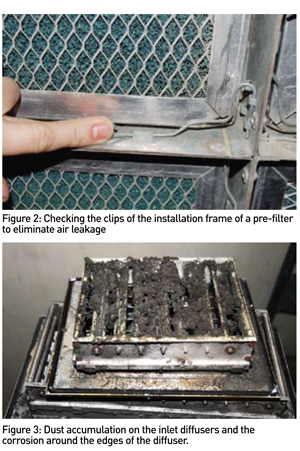In the sixth part of the series on air filtration, Iyad Al-Attar examines the impact of filter fouling on fan efficiency, heat transfer mechanism and the occupant’s thermal comfort.
When considering the role of air filters in a Heating, Ventilating and Air-Conditioning (HVAC) system, the emphasis is usually on how efficient the filter is in removing particles from air stream and how low its air resistance. However, what also needs to be considered is the impact of filter fouling or clogging on the integrity of HVAC equipment, indoor contamination distribution within the HVAC system and energy consumption. Simply put, if the filter’s pressure drop increases to double its initial value, due to dust settlement by different mechanisms, how do all these factors affect the fan efficiency, heat transfer mechanism and the occupant’s thermal comfort?
The most primitive practice of detecting filter fouling is visual inspection. It is very critical that it is done in a timely manner to take the necessary maintenance measures. However, living in the twenty first century, there are many devices that can sample the air, counting and sizing particles to provide a quick air quality check. Continuous pressure drop measurements are a key input since they determine the lifetime of the filter. To ensure that such measurements provide representative results, they need to be executed very meticulously. But still, this would not supersede the advantage of the conventional “visual inspection” practice as shown in Figure 1. If the filter has minor leakage, pressure drop increase will not represent that taking place inside the air handling unit. Leakage defeats the intended purpose of having filters, and air in the leakage vicinity will channel itself to bypass the filter causing lower efficiency. Therefore, tight installation of filters is of critical importance to eliminate leakage as shown in Figure 2. Further, it would be very interesting and informative to detect filter fouling through air conditioning thermal performance and energy consumption to be able to assess the magnitude of filter fouling and/or clogging impact on HVAC performance.
 If the air filter section in an air handling unit is left without inspection and/or any quantifiable measure to assess its performance, perhaps we are left to examine the last destination for air prior to inhaling it, namely, the air diffusers. Air diffusers can eventually reveal the inconvenient truth about the poor performance of air filters and the level of maintenance exercised previously at the source. Figure 3 shows an alarming dust accumulation on the inlet diffusers and the evident corrosion around the edges of the diffuser.
If the air filter section in an air handling unit is left without inspection and/or any quantifiable measure to assess its performance, perhaps we are left to examine the last destination for air prior to inhaling it, namely, the air diffusers. Air diffusers can eventually reveal the inconvenient truth about the poor performance of air filters and the level of maintenance exercised previously at the source. Figure 3 shows an alarming dust accumulation on the inlet diffusers and the evident corrosion around the edges of the diffuser.
The key is not just selecting any filters, but making appropriate filter selections for our HVAC systems. Although energy in the GCC region is mainly subsidised by the government, that does not by any means justify its waste. Reducing energy consumption provides an opportunity to use the saved energy in other applications. While energy might be subsidised regionally, this is not the case globally and its escalating costs make saving it the main driving force for power plant managers. To a much greater extent, efficient and aerodynamic filters play a vital role in providing clean air to the air intake of gas turbines. The lower the filters’ pressure drops, the lower the fuel consumption and the higher the energy out. Clearly, an air filter is a key building block for producing energy in gas turbines and for energy conservation in HVAC applications. Therefore, the possibility of introducing high-efficiency filters with lower pressure drop would have a significant impact on HVAC equipment and gas turbine performances.
Aerosol filtration
There is hardly any occasion where the subject of indoor or outdoor environments is addressed without highlighting the role of air filters and aerosol filtration. Accordingly to the Filtration Dictionary1, the terms aerosol refers to suspended particles in a gas. It is important to note that aerosol is defined as dispersion of particles smaller than one micrometer in a gas that show little or no tendency to settle and remain suspended indefinitely in the gas. Natural occurring aerosols normally contain a wide range of particle sizes (heterodispersed). Aerosol particles can be either solid or liquid. If the aerosol considered is made up of solid particles, they can be captured by either depth filtration or cake filtration processes. On the other hand, liquid aerosols tend to coalesce in the depth of a filter and move through the matrix of fibres under the force of gravity.
 The first step towards understanding aerosol filtration starts with knowing what our air filter would be up against. The second step would be physical and chemical characterisation to quantify the influential parameters affecting air filter performance. The first and foremost parameter is particle size distribution of the relevant contaminant. Particle size is the most important property because it affects its motion, the capture mechanism on a fibre, as well as filtration and control technologies. Particle size is considered to be a fundamental parameter for characterising the aerosol behaviour, as particle size and its distribution highly influence the filtration performance of an air filter. Therefore, particle sizing is a very important technique for characterising the dust as it provides valuable information to researchers and designers. Such knowledge is essential to select air filters appropriately. The learning journey to acquiring knowledge about the contaminants we are trying to filter starts with sampling. While there are several advanced sampling techniques available nowadays, filtration is the most common method aerosol sampling method, in addition to being a common method for air cleaning.
The first step towards understanding aerosol filtration starts with knowing what our air filter would be up against. The second step would be physical and chemical characterisation to quantify the influential parameters affecting air filter performance. The first and foremost parameter is particle size distribution of the relevant contaminant. Particle size is the most important property because it affects its motion, the capture mechanism on a fibre, as well as filtration and control technologies. Particle size is considered to be a fundamental parameter for characterising the aerosol behaviour, as particle size and its distribution highly influence the filtration performance of an air filter. Therefore, particle sizing is a very important technique for characterising the dust as it provides valuable information to researchers and designers. Such knowledge is essential to select air filters appropriately. The learning journey to acquiring knowledge about the contaminants we are trying to filter starts with sampling. While there are several advanced sampling techniques available nowadays, filtration is the most common method aerosol sampling method, in addition to being a common method for air cleaning.
The Interconnection
It is evident that the air filtration field is interconnected in one way or another to several fields in science and technology. Our indoor activities also produce contaminants and we need to assess the impact of exhausting them into the environment. Therefore, combining air filters and HVAC design can help in reducing our indoor emissions. Filtration also affects HVAC equipment, gas turbines and many industrial applications which all impact the environment. However, we ought to regard filtration as a necessity and clean air as a human right we owe to generations to come.
Care not friends
There are enormous challenges awaiting our environment and, certainly, filtration can play a major role in protecting it. Whether we are in the filtration, HVAC or gas turbine field, professionally, we all begin our technical discussions by asking the audience to be on the same page, but shouldn’t we first speak the same environmental language? The environment does not need friends, it needs care.
 The writer is Regional Director, Middle East, and International Consultant, EMW Filtertechnik, Germany. He can be contacted at iyad.al-attar@emw.de.
The writer is Regional Director, Middle East, and International Consultant, EMW Filtertechnik, Germany. He can be contacted at iyad.al-attar@emw.de.
References: 1 Tarleton E.S. and Wakeman R.J. 2008. “Dictionary of Filtration and Separation” Filtration Solutions, Filtration Solutions, Exeter.
Copyright © 2006-2025 - CPI Industry. All rights reserved.